Effect of Bone Quality, Implant Length, and Loading Timing on Stress Transmission in the Posterior Mandible: A Finite Element Analysis
Abstract
1. Introduction
- Atrophic mandibles result in higher peri-implant stress concentrations than normal or grafted models;
- Long implants reduce marginal stress and distribute occlusal forces more evenly than short implants;
- Delayed loading generates more favorable biomechanical outcomes by aligning force application with osseointegration.
2. Materials and Methods
2.1. Modeling of Cortical Bone, Trabecular Bone, and Teeth
- D2 corresponds to dense cortical bone with coarse trabecular bone (normal mandible);
- D3 indicates thinner cortical bone with a finer trabecular structure (grafted mandible);
- D4 represents minimal cortical bone and very fine trabeculae (atrophic mandible).
2.2. Modeling of Implants, Abutments, Screws, Mandibular Canal, and Graft: Creation of Study Models
2.3. Material Properties
- D2: 700 MPa;
- D3: 350 MPa;
- D4: 150 MPa;
- Poisson’s ratio for all trabecular bone types was taken as 0.30.
2.4. Generation of Mathematical Models
2.5. Loading Scenarios and Boundary Conditions
2.6. Quantitative Model Data
2.7. Assembly and Contact Definitions Between Components
- Immediate Loading: The friction coefficient at the interface was set to 0.3, simulating incomplete osseointegration.
- Early Loading: Partial osseointegration was assumed, and the friction coefficient was set to 0.5.
- Delayed Loading: Complete osseointegration was assumed, and a “FREEZE” contact condition was applied, implying no relative motion between components.
- Immediate Loading: A frictional contact with a coefficient of μ = 0.3 was defined to represent a clinical condition where osseointegration has not yet occurred. This allows for limited relative micromotion between the implant and the bone, mimicking the initial healing period.
- Early Loading: A frictional contact with a higher friction coefficient of μ = 0.5 was used to simulate partial osseointegration and increased mechanical interlocking, reflecting conditions after initial bone healing but before full integration.
- Delayed Loading: For fully osseointegrated implants, a “FREEZE” contact condition was applied. This model enforces complete coupling between surfaces, preventing any relative displacement or sliding, thereby simulating mature bone–implant integration.
- Crown–abutment;
- Abutment–implant;
- Screw–implant;
- Implant–crown.
3. Results
Parameter-Based Comparisons
3.1.1. Von Mises Stresses in the Implant Body
3.1.2. Von Mises Stresses at the Abutment Level
3.1.3. Von Mises Stresses Around the Mandibular Canal
3.1.4. Maximum (Tensile) Principal Stresses at Cortical Bone Point P1
3.1.5. Maximum (Compressive) Principal Stresses at Point P3 in Cortical Bone
3.1.6. Maximum (Tensile) Principal Stresses at the P1 Point in Trabecular Bone
3.1.7. Minimum (Compressive) Principal Stresses at P3 Point in Trabecular Bone
4. Discussion
5. Conclusions
- Implant length significantly influenced peri-implant stress distribution.
- Loading timing played a critical role in stress modulation.
- Oblique loading was the most potent factor in amplifying stress within the implant system.
- Mandibular bone condition markedly affected stress patterns.
- The mandibular canal region proved highly sensitive to loading conditions.
- Grafting effectively reduced stress in both cortical and trabecular bone.
- Stress distribution varied between the implant’s cervical and body regions.
Author Contributions
Funding
Institutional Review Board Statement
Data Availability Statement
Acknowledgments
Conflicts of Interest
Abbreviations
| FEA | Finite Element Analysis |
| MPa | Megapascal |
| 3D | Three-Dimensional |
| HU | Hounsfield Unit |
| CAD-CAM | Computer-Aided Design and Computer-Aided Manufacturing |
| N | Newton |
| mm | Millimeter |
References
- Howe, M.-S.; Keys, W.; Richards, D. Long-term (10-year) dental implant survival: A systematic review and sensitivity meta-analysis. J. Dent. 2019, 84, 9–21. [Google Scholar] [CrossRef] [PubMed]
- Esposito, M.; Grusovin, M.G.; Coulthard, P.; Worthington, H.V. The efficacy of various bone augmentation procedures for dental implants: A Cochrane systematic review of randomized controlled clinical trials. Cochrane Database Syst. Rev. 2006, 2006, CD003607. [Google Scholar]
- Renouard, F.; Nisand, D. Impact of implant length and diameter on survival rates. Clin. Oral Implants Res. 2006, 17 (Suppl. S2), 35–51. [Google Scholar] [CrossRef] [PubMed]
- Rameh, S.; Menhall, A.; Younes, R. Key factors influencing short implant success. Oral Maxillofac. Surg. 2020, 24, 263–275. [Google Scholar] [CrossRef]
- McAllister, B.S.; Haghighat, K. Bone augmentation techniques. J. Periodontol. 2007, 78, 377–396. [Google Scholar] [CrossRef]
- Tolstunov, L.; Hamrick, J.F.E.; Broumand, V.; Shilo, D.; Rachmiel, A. Bone augmentation techniques for horizontal and vertical alveolar ridge deficiency in oral implantology. Oral Maxillofac. Surg. Clin. N. Am. 2019, 31, 163–191. [Google Scholar] [CrossRef]
- Sunar, A.; Develioğlu, A.H. Causes of failure in dental implants: Current perspectives. J. Kocaeli Health Technol. Univ. 2023, 1, 48–58. [Google Scholar]
- Kitagawa, T.; Tanimoto, Y.; Nemoto, K.; Aida, M. Influence of cortical bone quality on stress distribution in bone around dental implant. Dent. Mater. J. 2005, 24, 219–224. [Google Scholar] [CrossRef]
- Geng, J.P.; Tan, K.B.C.; Liu, G.R. Application of finite element analysis in implant dentistry: A review of the literature. J. Prosthet. Dent. 2001, 85, 585–598. [Google Scholar] [CrossRef]
- Quaresma, S.E.T.; Cury, P.R.; Sendyk, W.R.; Sendyk, C. A finite element analysis of two different dental implants: Stress distribution in the prosthesis, abutment, implant, and supporting bone. J. Appl. Oral Sci. 2008, 16, 25–30. [Google Scholar] [CrossRef]
- Lekholm, U.; Zarb, G.A. Patient selection and preparation. In Tissue-Integrated Prostheses: Osseointegration in Clinical Dentistry; Branemark, P.I., Zarb, G.A., Albrektsson, T., Eds.; Quintessence Publishing: Chicago, IL, USA, 1985; pp. 199–209. [Google Scholar]
- Seong, W.-J.; Kim, U.-K.; Swift, J.Q.; Heo, Y.-C.; Hodges, J.S.; Ko, C.-C. Elastic properties and apparent density of human edentulous maxilla and mandible. Int. J. Oral Maxillofac. Surg. 2009, 38, 1088–1093. [Google Scholar] [CrossRef] [PubMed]
- Akça, K.; Cehreli, M.C. Biomechanical consequences of progressive loading on implant–bone interface: A finite element stress analysis. Int. J. Oral Maxillofac. Implants 2006, 21, 304–312. [Google Scholar]
- Van Staden, R.C.; Guan, H.; Loo, Y.C. Application of the finite element method in dental implant research. Comput. Methods Biomech. Biomed. Eng. 2006, 9, 257–270. [Google Scholar] [CrossRef] [PubMed]
- Natali, A.N.; Pavan, P.G.; Ruggero, A.L. Analysis of bone–implant interaction phenomena by using a numerical approach. Clin. Oral Implants Res. 2003, 14, 103–113. [Google Scholar] [CrossRef]
- Oshida, Y.; Tuna, E.B.; Aktören, O.; Gençay, K. Dental implant systems. Int. J. Mol. Sci. 2010, 11, 1580–1678. [Google Scholar] [CrossRef]
- Sakaguchi, R.L.; Powers, J.M. Craig’s Restorative Dental Materials, 12th ed.; Mosby: St. Louis, MO, USA, 2002. [Google Scholar]
- Ding, X.; Zhu, X.H.; Liao, S.H.; Zhang, X.H.; Chen, H. Implant-bone interface stress distribution in immediately loaded implants of different diameters: A three-dimensional finite element analysis. J. Prosthodont. 2009, 18, 393–402. [Google Scholar] [CrossRef]
- Dhanasekaran, T.; Andonissamy, L.; Abdullah, F.; Paramasivam, Y.S. Effect of different occlusal materials on peri-implant stress distribution with different osseointegration condition: A finite element analysis. J. Indian Prosthodont. Soc. 2024, 24, 292–299. [Google Scholar] [CrossRef]
- Sertgöz, A.; Güvener, S. Finite element analysis of the effect of cantilever and implant length on stress distribution in an implant-supported fixed prothesis. J. Prosthet. Dent. 1996, 76, 165–169. [Google Scholar] [CrossRef]
- Zupancic Cepic, L.; Frank, M.; Reisinger, A.; Pahr, D.; Zechner, W.; Schedle, A. Biomechanical finite element analysis of short-implant-supported, 3-unit, fixed CAD/CAM prostheses in the posterior mandible. Int. J. Implant Dent. 2022, 8, 1. [Google Scholar] [CrossRef]
- Dasmah, A.; Thor, A.; Ekestubbe, A.; Sennerby, L.; Rasmusson, L. Particulate vs. block bone grafts: Three-dimensional changes in graft volume after reconstruction of the atrophic maxilla, a 2-year radiographic follow-up. J. Craniomaxillofac. Surg. 2012, 40, 654–659. [Google Scholar] [CrossRef]
- Misch, C.E.; Qu, Z.; Bidez, M.W. Mechanical properties of trabecular bone in the human mandible: Implications for dental implant treatment planning and surgical placement. J. Oral Maxillofac. Surg. 1999, 57, 700–706. [Google Scholar] [CrossRef]
- Pjetursson, B.E.; Tan, W.C.; Zwahlen, M.; Lang, N.P. A systematic review of the success of sinus floor elevation and survival of implants inserted in combination with sinus floor elevation: Part I: Lateral approach. J. Clin. Periodontol. 2008, 35 (Suppl. S8), 216–240. [Google Scholar] [CrossRef] [PubMed]
- Rasmusson, L.; Thor, A.; Sennerby, L. Stability evaluation of implants integrated in grafted and nongrafted maxillary bone: A clinical study from implant placement to abutment connection. Clin. Implant Dent. Relat. Res. 2012, 14, 61–66. [Google Scholar] [CrossRef] [PubMed]
- Sailer, I.; Pjetursson, B.E.; Zwahlen, M.; Hämmerle, C.H.F. A systematic review of the survival and complication rates of all-ceramic and metal-ceramic reconstructions after an observation period of at least 3 years. Part II: Fixed dental prostheses. Clin. Oral Implants Res. 2007, 18 (Suppl. S3), 86–96. [Google Scholar] [CrossRef] [PubMed]
- Chun, H.J.; Cheong, S.Y.; Han, J.H.; Heo, H.J.; Chung, J.P.; Rhyu, I.C.; Choi, Y.C.; Baik, H.K.; Ku, Y.; Kim, M.H. Evaluation of design parameters of osseointegrated dental implants using finite element analysis. J. Oral Rehabil. 2002, 29, 565–574. [Google Scholar] [CrossRef]
- Esposito, M.; Ardebili, Y.; Worthington, H.V. Interventions for replacing missing teeth: Different types of dental implants (Review). Cochrane Database Syst. Rev. 2014, 2014, CD003815. [Google Scholar] [CrossRef]
- Papavasiliou, G.; Kamposiora, P.; Bayne, S.C.; Felton, D.A. Three-dimensional finite element analysis of stress distribution around single tooth implants as a function of bony support, prosthesis type, and loading during function. J. Prosthet. Dent. 1996, 76, 633–640. [Google Scholar] [CrossRef]
- Gallucci, G.; Benic, G.; Eckert, S.; Papaspyridakos, P.; Schimmel, M.; Schrott, A.; Weber, H.-P. Consensus statements and clinical recommendations for implant loading protocols. Int. J. Oral Maxillofac. Implants 2014, 29, 287–290. [Google Scholar] [CrossRef]
- Glauser, R.; Røkkedal-Rækken, A.; Lundgren, A.; Gottlow, J.; Hämmerle, C.H.F.; Schärer, P. Immediate occlusal loading of Brånemark implants applied in various jawbone regions: A prospective, 1-year clinical study. Clin. Implant Dent. Relat. Res. 2001, 3, 204–213. [Google Scholar] [CrossRef]
- Huynh-Ba, G.; Oates, T.W.; Williams, M.A.H. Immediate loading vs. early/conventional loading of immediately placed implants in partially edentulous patients from the patients’ perspective: A systematic review. Clin. Oral Implants Res. 2018, 29, 255–269. [Google Scholar] [CrossRef]
- Zhu, Y.; Zheng, X.; Zeng, G.; Xu, Y.; Qu, X.; Zhu, M.; Lu, E. Clinical efficacy of early loading versus conventional loading of dental implants. Sci. Rep. 2015, 5, 15995. [Google Scholar] [CrossRef] [PubMed]
- Alsubaiy, E.F. Abutment screw loosening in implants: A literature review. J. Family Med. Prim. Care 2020, 9, 5490–5494. [Google Scholar] [CrossRef] [PubMed]
- Lenz, U.; Dos Santos, R.B.; Satpathy, M.; Griggs, J.A.; Della Bona, A. Fatigue resistance of customized implant-supported restorations. Materials 2025, 18, 3420. [Google Scholar] [CrossRef] [PubMed]
- Tribst, J.P.M.; Dal Piva, A.M.O.; da Silva-Concílio, L.R.; Ausiello, P.; Kalman, L. Influence of implant–abutment contact surfaces and prosthetic screw tightening on the stress concentration, fatigue life and microgap formation: A finite element analysis. Oral 2021, 1, 88–101. [Google Scholar] [CrossRef]
- Keil, C.; Gollmer, B.; Zeidler-Rentzsch, I.; Gredes, T.; Heinemann, F. Histological evaluation of extraction sites grafted with Bio-Oss Collagen: Randomized controlled trial. Ann. Anat. 2021, 237, 151722. [Google Scholar] [CrossRef]
- Ronsivalle, V.; Lo Giudice, P.; Santonocito, S.; Bocchieri, S.; Giudice, R.; Battaglia, S.; Crimi, S.; Bianchi, A.; Cicciù, M. Finite element method of subperiosteal implants: A systematic review on biomechanical performance and stress distribution. J. Craniomaxillofac. Surg. 2025, 53, 1275–1282. [Google Scholar] [CrossRef]
- Troeltzsch, M.; Troeltzsch, M.; Kauffmann, P.; Gruber, R.; Brockmeyer, P.; Moser, N.; Rau, A.; Schliephake, H. Clinical efficacy of grafting materials in alveolar ridge augmentation: A systematic review. J. Craniomaxillofac. Surg. 2016, 44, 1618–1629. [Google Scholar] [CrossRef]
- Fanuscu, M.I.; Vu, H.V.; Poncelet, B. Implant biomechanics in grafted sinus: A finite element analysis. J. Oral Implantol. 2004, 30, 134–138. [Google Scholar] [CrossRef]
- Yoon, Y.; Kim, J.E.; Kim, E.; Park, S.; Kang, I.; Kwon, Y.D. Stability of the implant–alveolar bone complex according to the peri-implant bone loss and bone quality: A finite element analysis study. Appl. Sci. 2024, 14, 11674. [Google Scholar] [CrossRef]
- Zhang, J.; Zhang, W.; Yue, W.; Qin, W.; Zhao, Y.; Xu, G. Research progress of bone grafting: A comprehensive review. Int. J. Nanomed. 2025, 20, 4729–4757. [Google Scholar] [CrossRef]
- Chrcanovic, B.; Albrektsson, T.; Wennerberg, A. Bone quality and quantity and dental implant failure: A systematic review and meta-analysis. Int. J. Prosthodont. 2017, 30, 219–237. [Google Scholar] [CrossRef] [PubMed]
- Lang, N.P.; Salvi, G.E.; Huynh-Ba, G.; Ivanovski, S.; Donos, N.; Bosshardt, D.D. Early osseointegration to hydrophilic and hydrophobic implant surfaces in humans. Clin. Oral Implants Res. 2011, 22, 349–356. [Google Scholar] [CrossRef] [PubMed]
- Raghavendra, S.; Wood, M.C.; Taylor, T.D. Early wound healing around endosseous implants: A review of the literature. Int. J. Oral Maxillofac. Implants 2005, 20, 425–431. [Google Scholar] [PubMed]
- Buser, D.; Schenk, R.K.; Steinemann, S.; Fiorellini, J.P.; Fox, C.H.; Stich, H. Influence of surface characteristics on bone integration of titanium implants: A histomorphometric study in miniature pigs. J. Biomed. Mater. Res. 1991, 25, 889–902. [Google Scholar] [CrossRef]
- Wennerberg, A.; Albrektsson, T. Effects of titanium surface topography on bone integration: A systematic review. Clin. Oral Implants Res. 2009, 20 (Suppl. S4), 172–184. [Google Scholar] [CrossRef]
- Han, J.Y.; Hou, J.X.; Zhou, G.; Wang, C.; Fan, Y.B. A histological and biomechanical study of bone stress and bone remodeling around immediately loaded implants. Sci. China Life Sci. 2014, 57, 618–626. [Google Scholar] [CrossRef]
- Irandoust, S.; Müftü, S. The interplay between bone healing and remodeling around dental implants. Sci. Rep. 2020, 10, 4335. [Google Scholar] [CrossRef]
- Wu, W.; Song, L.; Liu, J.; Du, L.; Zhang, Y.; Chen, Y.; Tang, Z.; Shen, M. Finite element analysis of the angle range in trans-inferior alveolar nerve implantation at the mandibular second molar. BMC Oral Health 2023, 23, 641. [Google Scholar] [CrossRef]
- Frost, H.M. Wolff’s Law and Bone’s Structural Adaptations to Mechanical Usage: An Overview for Clinicians. Angle Orthod. 1994, 64, 175–188. [Google Scholar]
- Frost, H.M. Bone’s Mechanostat: A 2003 Update. Anat. Rec. A Discov. Mol. Cell. Evol. Biol. 2003, 275, 1081–1101. [Google Scholar] [CrossRef]
- Juodzbalys, G.; Wang, H.-L.; Sabalys, G. Anatomy of Mandibular Vital Structures. Part I: Mandibular Canal and Inferior Alveolar Neurovascular Bundle in Relation with Dental Implantology. J. Oral Maxillofac. Res. 2010, 1, e2. [Google Scholar] [CrossRef]
- Uchida, Y.; Noguchi, N.; Goto, M.; Yamashita, Y.; Hanihara, T.; Takamori, H.; Sato, I.; Kawai, T.; Yosue, T. Measurement of Anterior Loop Length for the Mandibular Canal and Diameter of the Mandibular Incisive Canal to Avoid Nerve Damage When Installing Endosseous Implants in the Interforaminal Region: A Second Attempt Introducing Cone Beam Computed Tomography. J. Oral Maxillofac. Surg. 2009, 67, 744–750. [Google Scholar] [CrossRef] [PubMed]
- Valenzuela-Fuenzalida, J.J.; Cariseo, C.; Gold, M.; Díaz, D.; Orellana, M.; Iwanaga, J. Anatomical variations of the mandibular canal and their clinical implications in dental practice: A literature review. Surg. Radiol. Anat. 2021, 43, 1259–1272. [Google Scholar] [CrossRef] [PubMed]
- Kim, T.-E.; You, J.-S.; Moon, S.-Y.; Oh, J.-S.; Choi, H.-I.; Kim, S.-W. A retrospective study of 5-year marginal bone loss and influencing factors of Osstem TSIII implant. Oral Biol. Res. 2023, 47, 95–102. [Google Scholar] [CrossRef]
- Limbert, G.; van Lierde, C.; Muraru, O.L.; Walboomers, X.F.; Frank, M.; Hansson, S.; Middleton, J.; Jaecques, S. Trabecular bone strains around a dental implant and associated micromotions—A micro-CT-based three-dimensional finite element study. J. Biomech. 2010, 43, 1251–1261. [Google Scholar] [CrossRef]
- Schulz, A.; Klär, V.; Grobecker-Karl, T.; Karl, M. Biomechanical Rationale for a Novel Implant Design Reducing Stress on Buccal Bone. Appl. Sci. 2023, 13, 666. [Google Scholar] [CrossRef]
- Ceddia, M.; Romasco, T.; De Bortoli, N.; Mello, B.F.; Piattelli, A.; Mijiritsky, E.; Di Pietro, N.; Trentadue, B. Biomechanical Finite Element Analysis of Two Types of Short-Angled Implants Across Various Bone Classifications. Materials 2024, 17, 5680. [Google Scholar] [CrossRef]
- Gomes, L.C.L.; Pierre, F.Z.; Tribst, J.P.M.; de Carvalho Ramos, N.; Bresciani, E.; de Araújo, R.M.; Nogueira Júnior, L.; Bottino, M.A. Occlusal Scheme Effect on the Biomechanical Response of Full-Arch Dental Prosthesis Supported by Titanium Implants: A Systematic Review. Metals 2021, 11, 1574. [Google Scholar] [CrossRef]
- Kim, Y.; Oh, T.J.; Misch, C.E.; Wang, H.L. Occlusal considerations in implant therapy: Clinical guidelines with biomechanical rationale. Clin. Oral Implants Res. 2005, 16, 26–35. [Google Scholar] [CrossRef]
- Sheridan, R.A.; Decker, A.M.; Plonka, A.B.; Wang, H.L. The role of occlusion in implant therapy: A comprehensive updated review. Implant Dent. 2016, 25, 829–838. [Google Scholar] [CrossRef]
- Cook, S.D.; Klawitter, J.J.; Weinstein, A.M. The influence of implant geometry on the stress distribution around dental implants. J. Biomed. Mater. Res. 1982, 15, 237–247. [Google Scholar] [CrossRef]
- Himmlová, L.; Dostálová, J.; Kácovský, A.; Konvič, S. Influence of implant length and diameter on stress distribution: A finite element analysis. J. Prosthet. Dent. 2004, 91, 20–25. [Google Scholar] [CrossRef]
- Albrektsson, T.; Chrcanovic, B.; Jacobsson, M.; Wennerberg, A. Osseointegration of implants—A biological and clinical overview. JSM Dent. Surg. 2017, 2, 1022. [Google Scholar]
- Schwarz, F.; Sager, M.; Ferrari, D.; Herten, M.; Wieland, M.; Becker, J. Bone regeneration in dehiscence-type defects at non-submerged and submerged chemically modified (SLActive®) and conventional SLA titanium implants: An immunohistochemical study in dogs. J. Clin. Periodontol. 2008, 35, 64–75. [Google Scholar] [CrossRef]
- Berglundh, T.; Armitage, G.; Araujo, M.G.; Avila-Ortiz, G.; Blanco, J.; Camargo, P.M.; Chen, S.; Cochran, D.; Derks, J.; Figuero, E.; et al. Peri-implant diseases and conditions: Consensus report of workgroup 4 of the 2017 World Workshop on the Classification of Periodontal and Peri-Implant Diseases and Conditions. J. Clin. Periodontol. 2018, 45, S286–S291. [Google Scholar] [CrossRef] [PubMed]
- Bansal, S.; Managutti, A.; Babhulkar, A.; Patel, N. Artificial intelligence in oral and maxillofacial surgery: A road ahead. J. Oral Med. Oral Surg. Oral Pathol. Oral Radiol. 2024, 10, 254–260. [Google Scholar] [CrossRef]
- Gillot, M.; Miranda, F.; Baquero, B.; Ruellas, A.; Gurgel, M.; Al Turkestani, N.; Anchling, L.; Hutin, N.; Biggs, E.; Yatabe, M.; et al. Automatic landmark identification in cone-beam computed tomography. Orthod. Craniofac. Res. 2023, 26, 560–567. [Google Scholar] [CrossRef] [PubMed]
- Vázquez-Sebrango, G.; Anitua, E.; Macía, I.; Arganda-Carreras, I. The role of artificial intelligence in implant dentistry: A systematic review. Int. J. Oral Maxillofac. Surg. 2025, in press. [CrossRef]
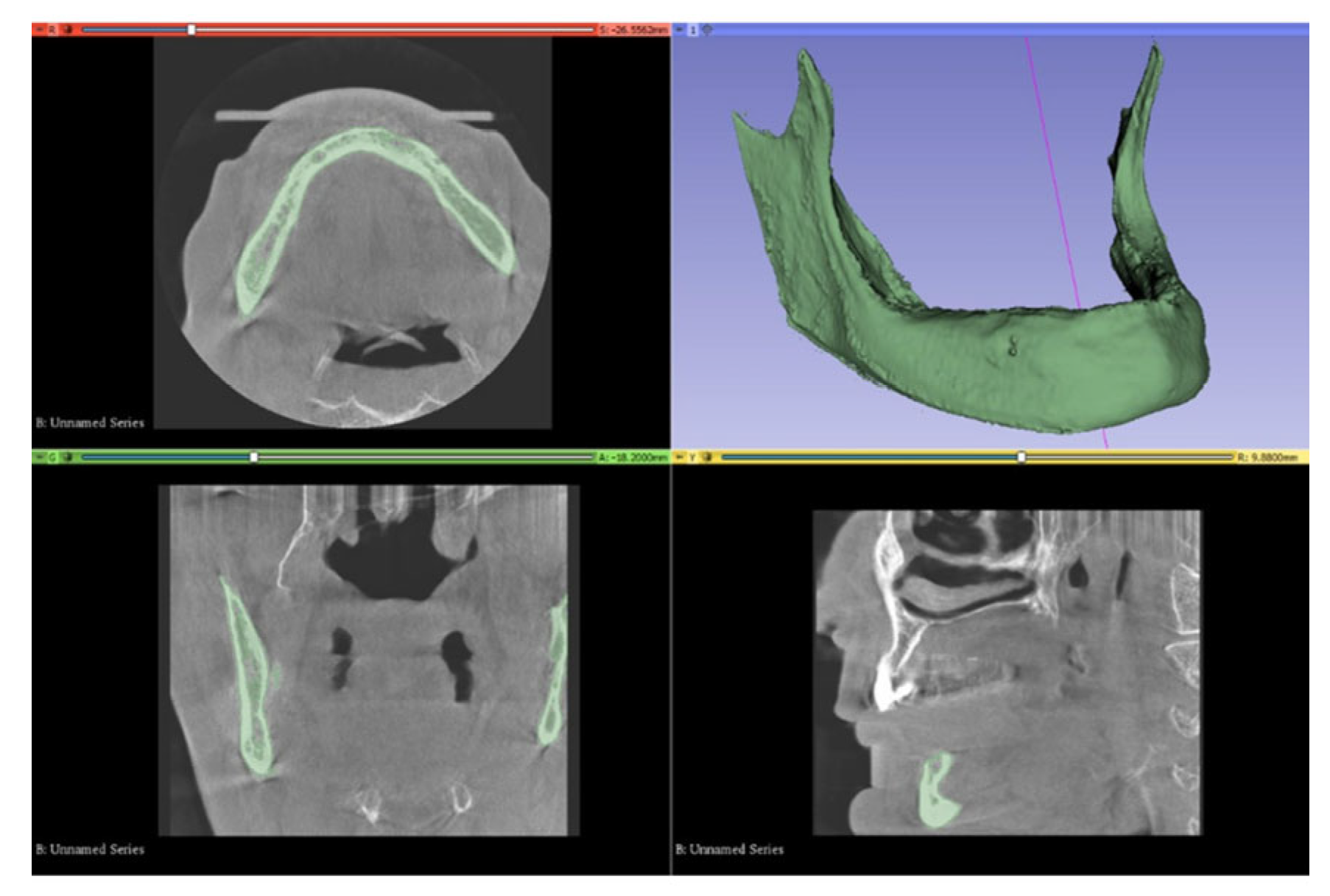
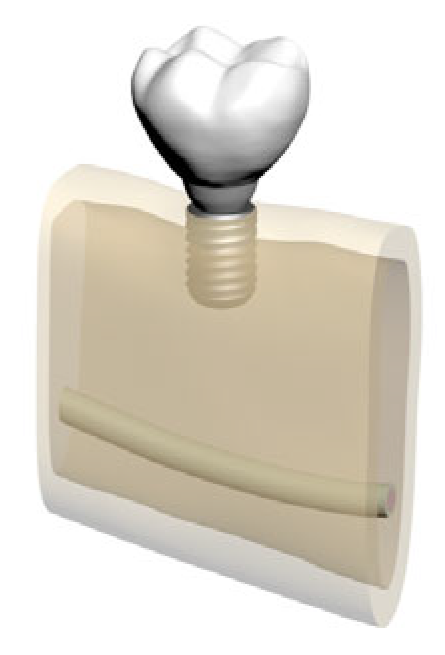
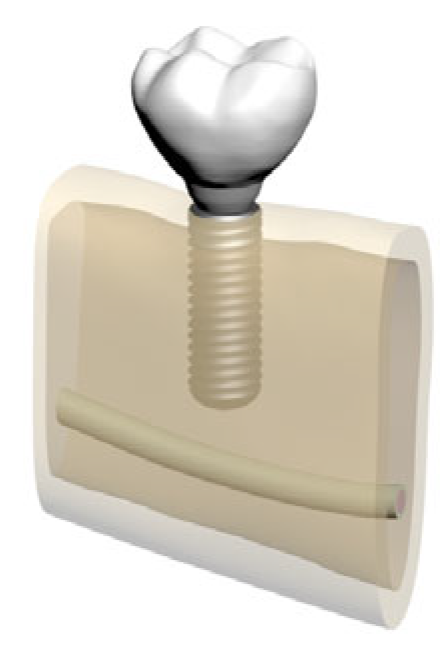
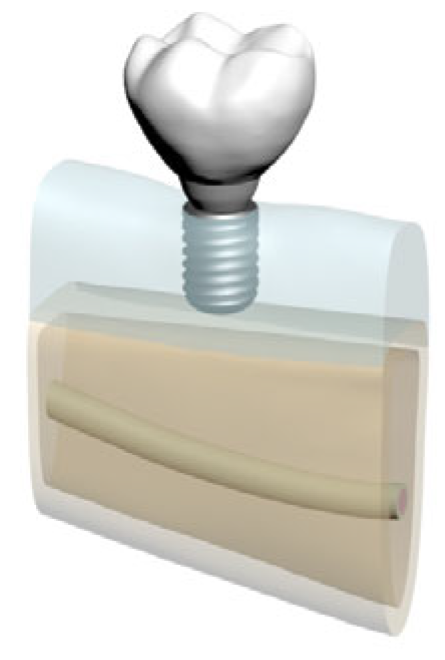
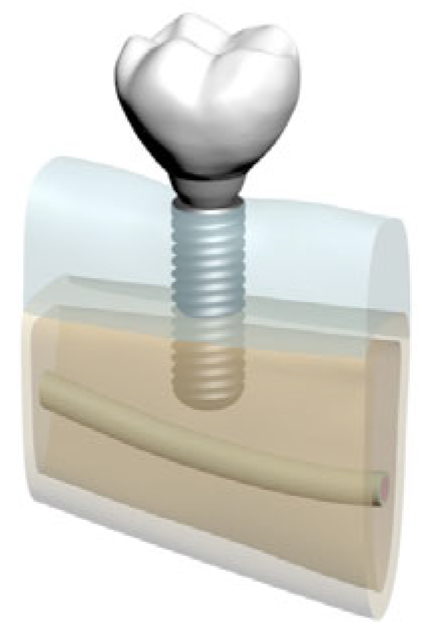
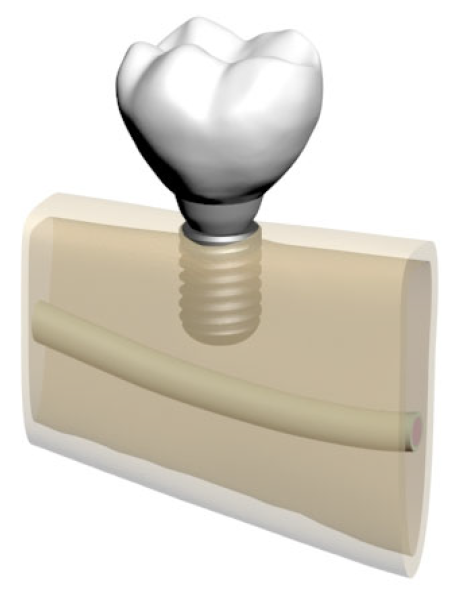

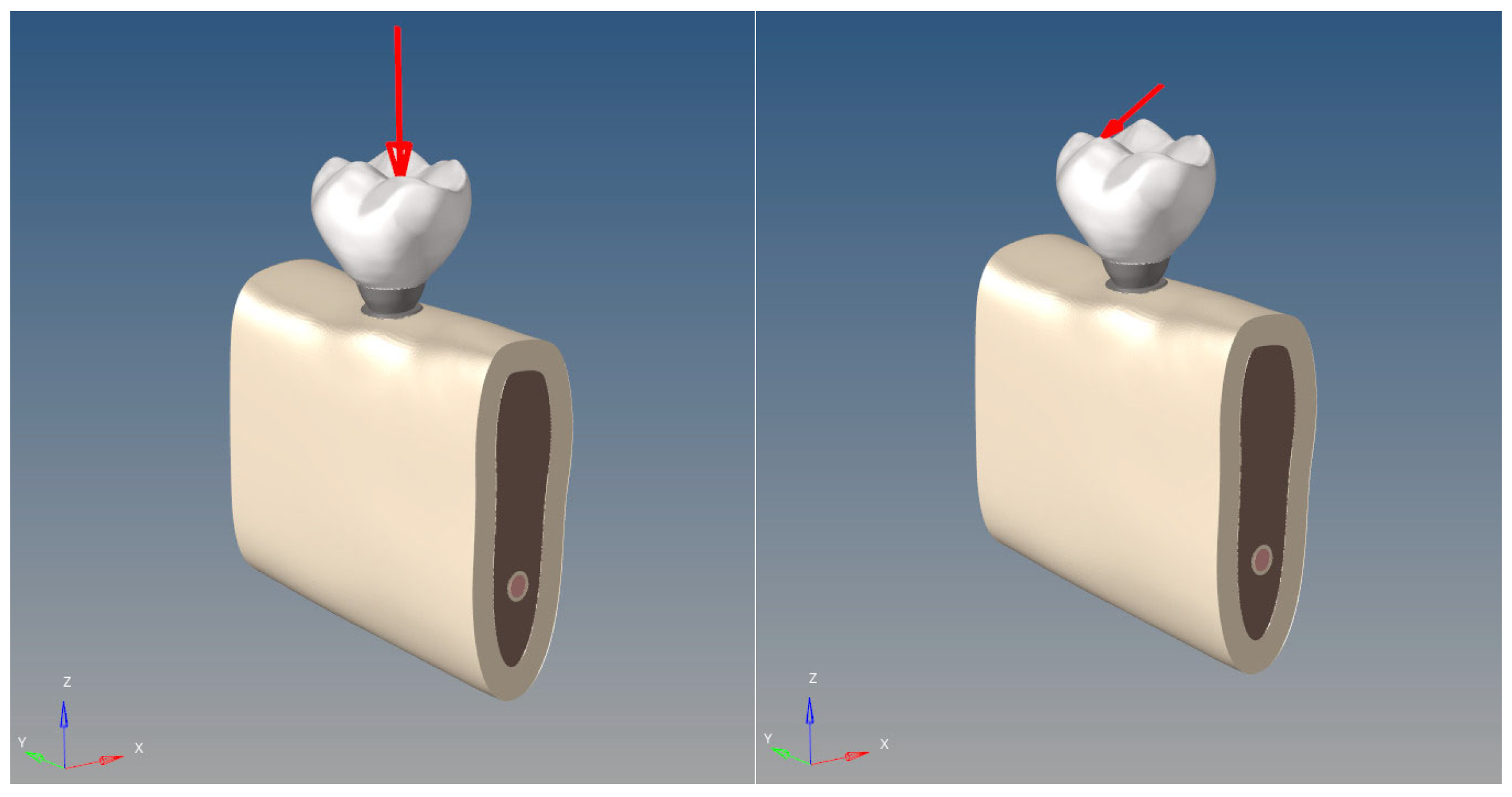
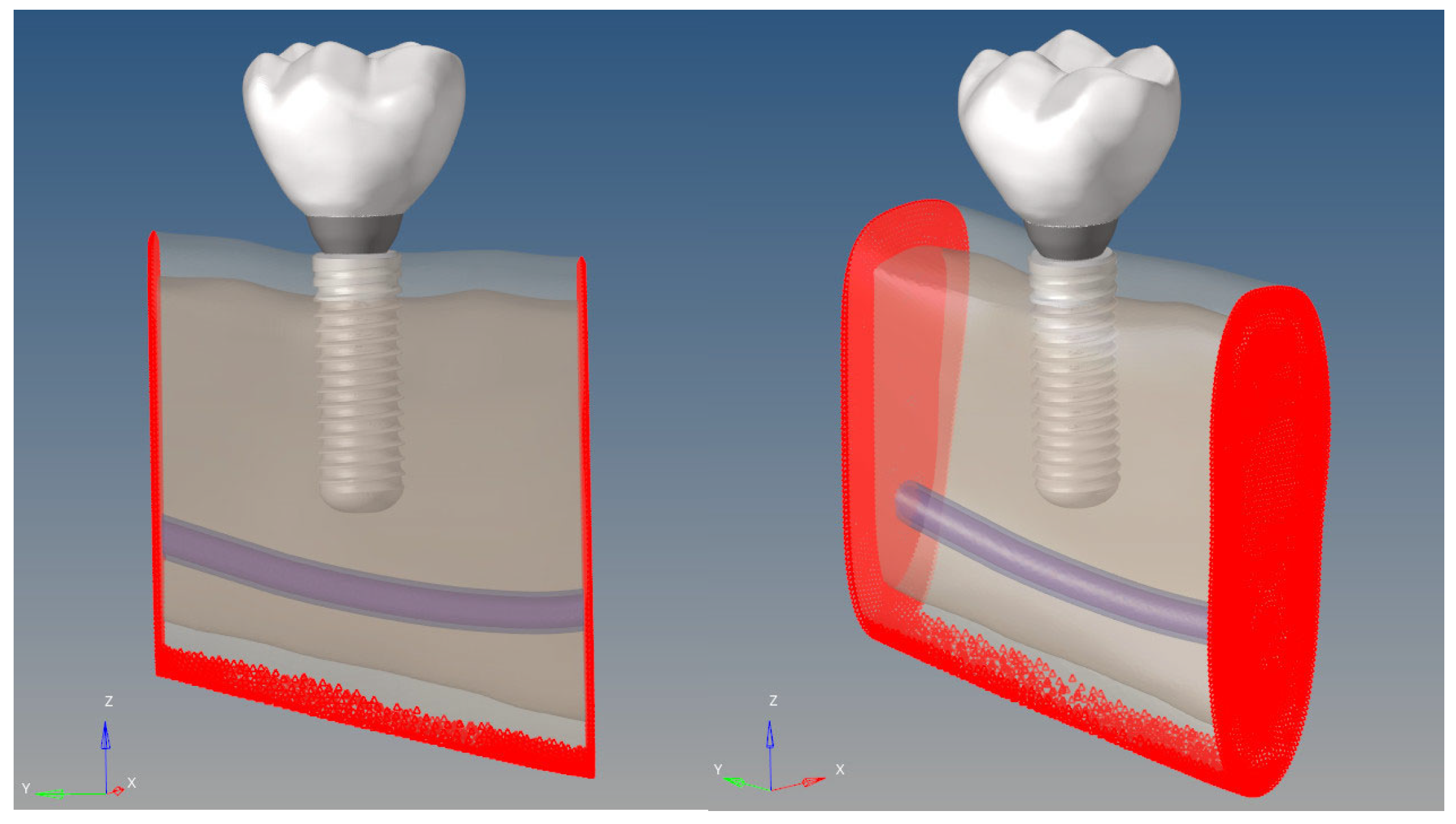
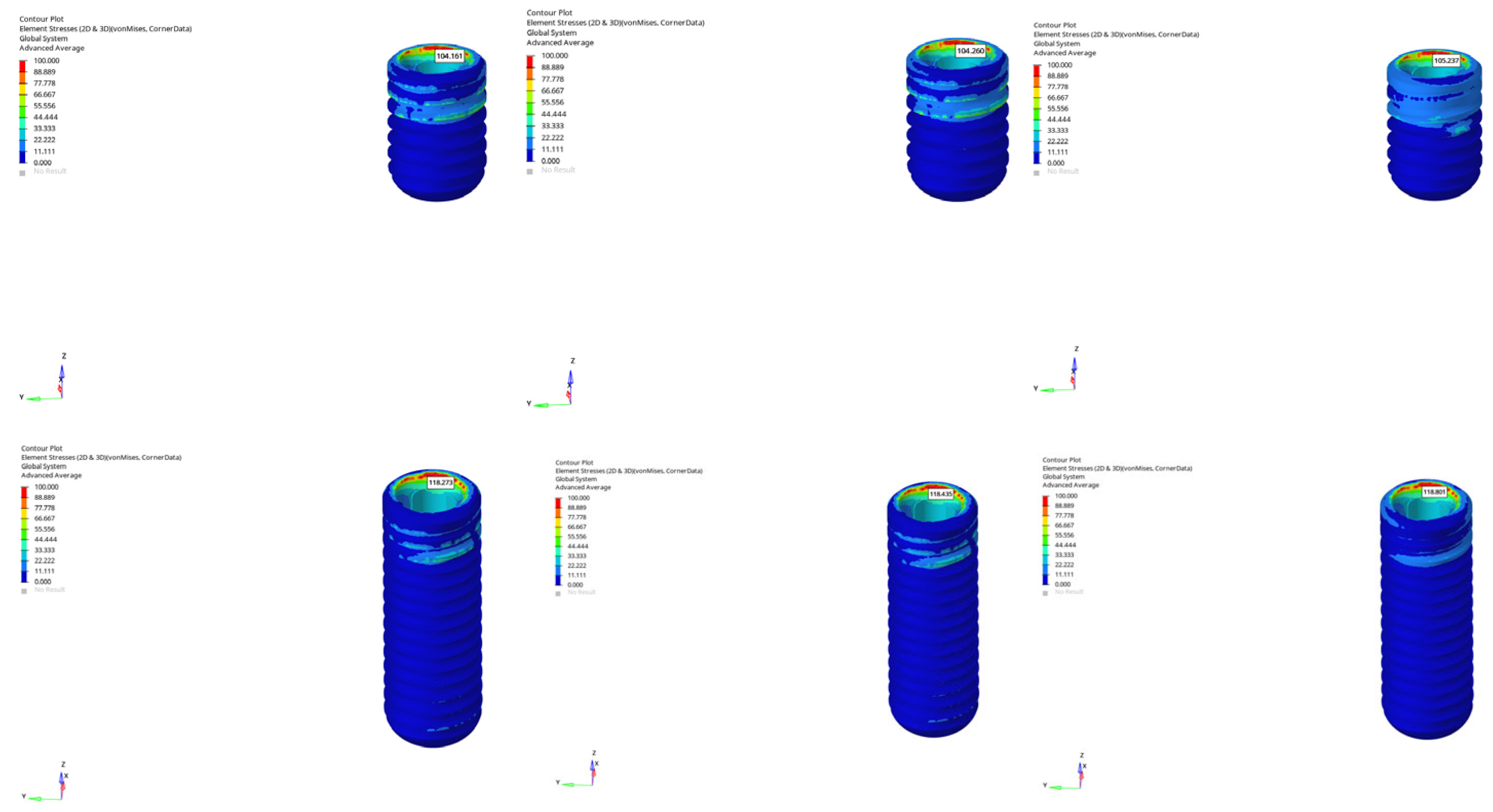




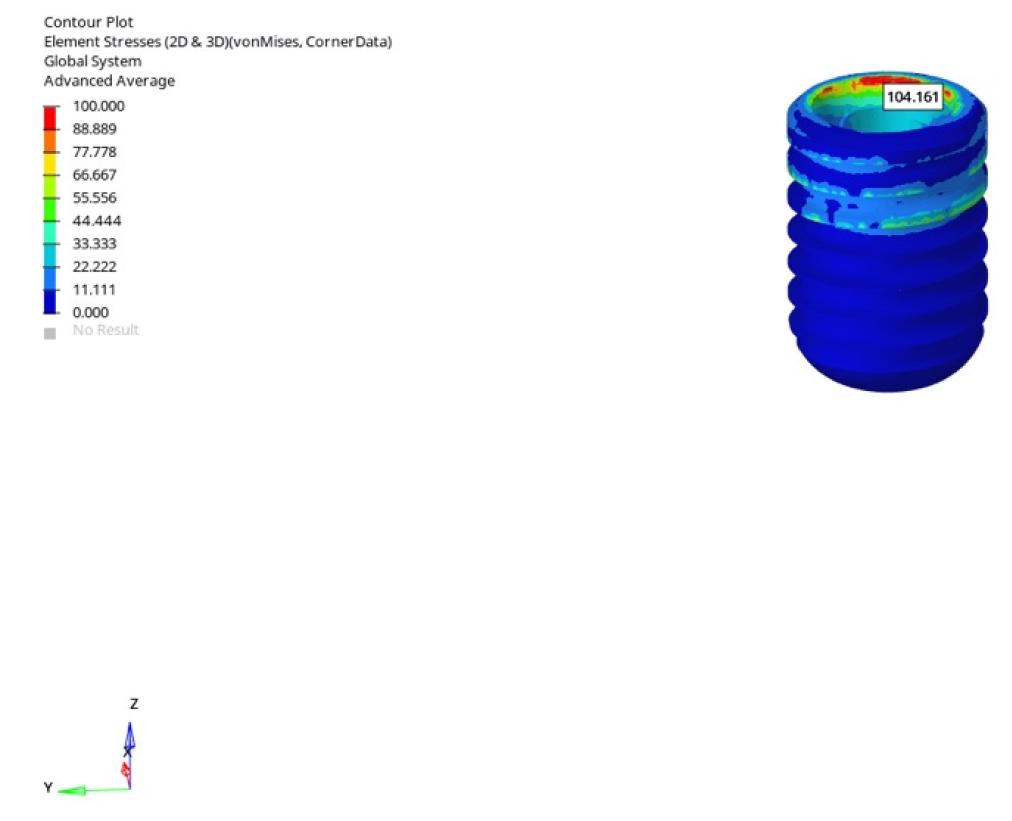
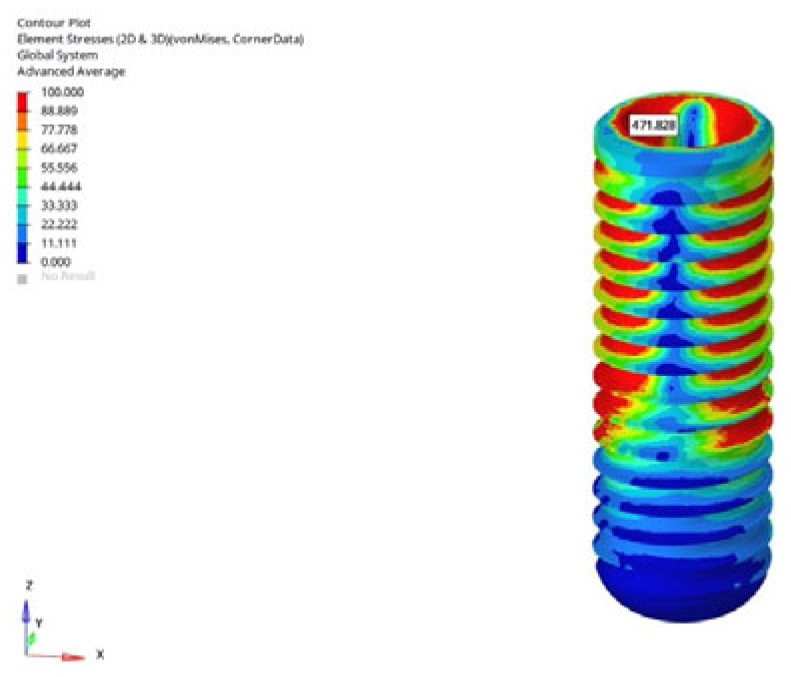




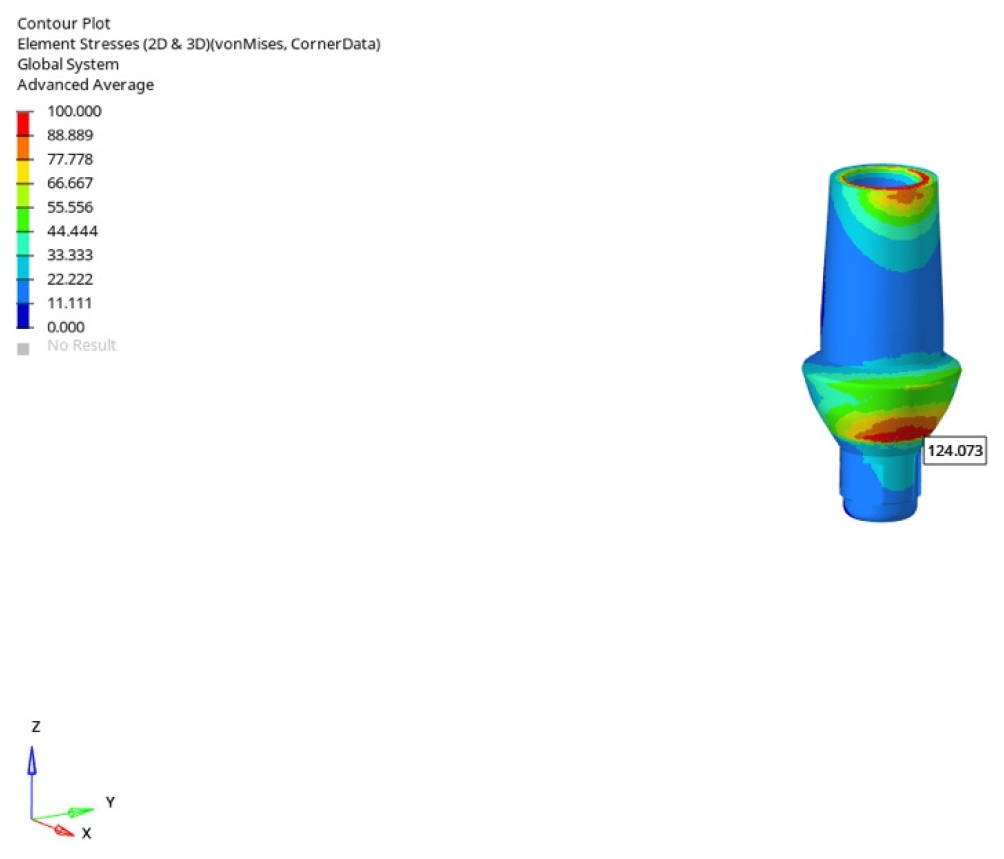
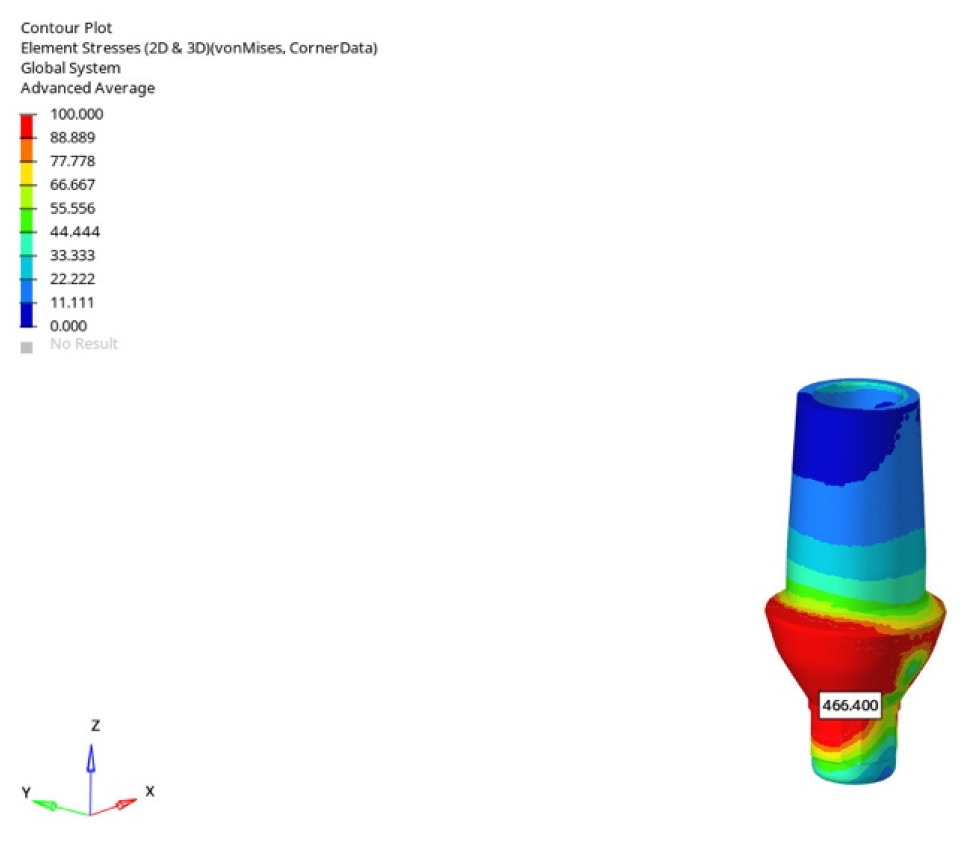


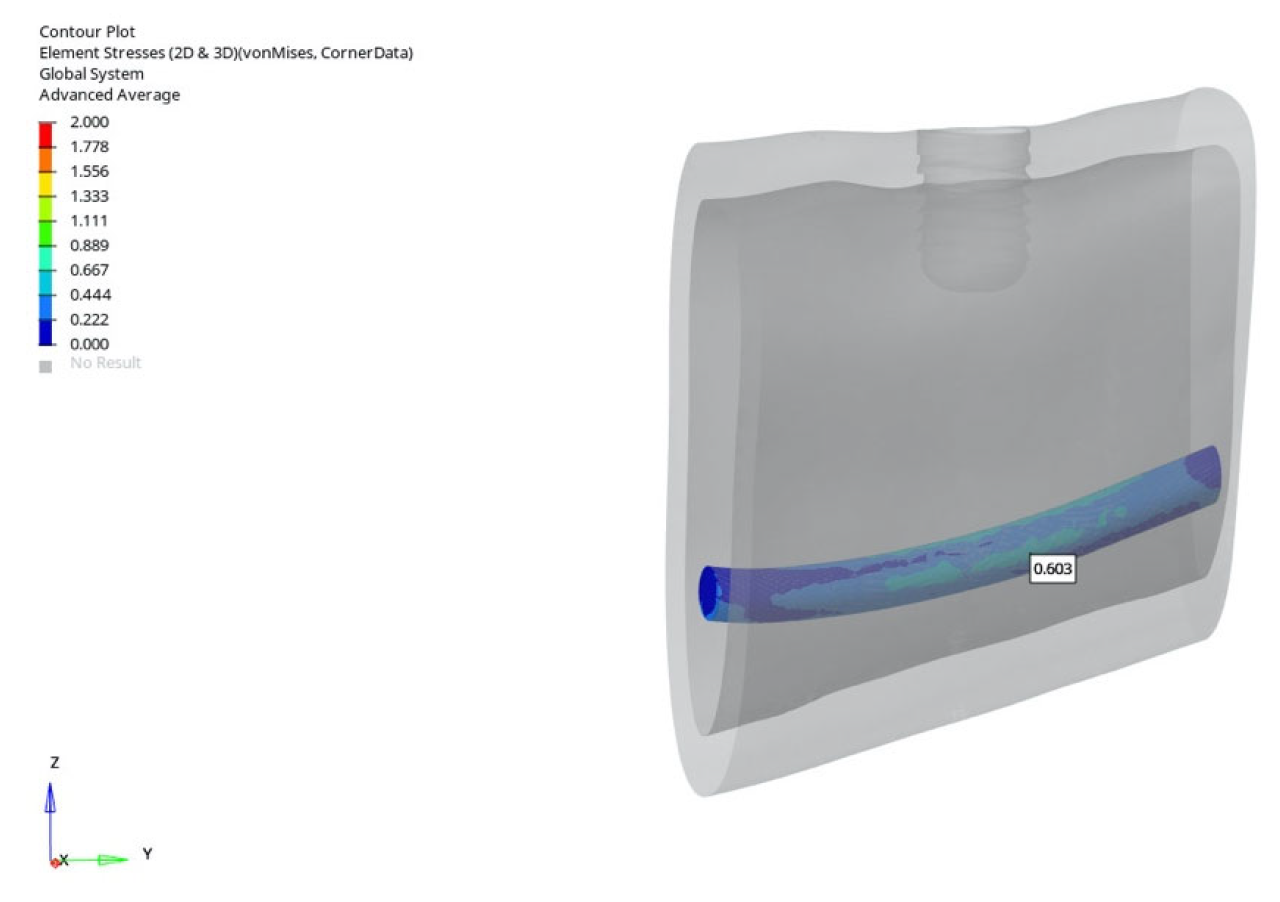
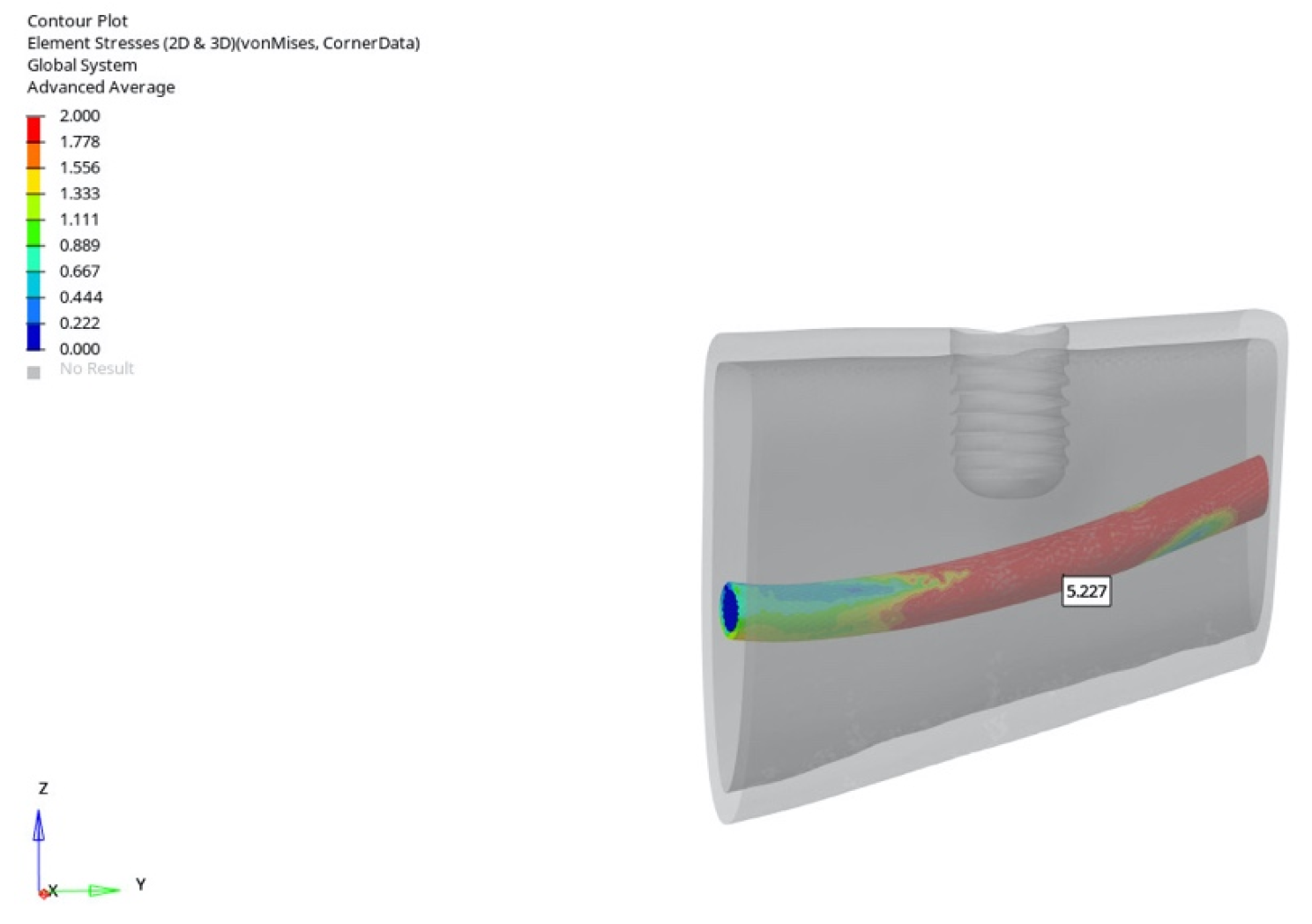


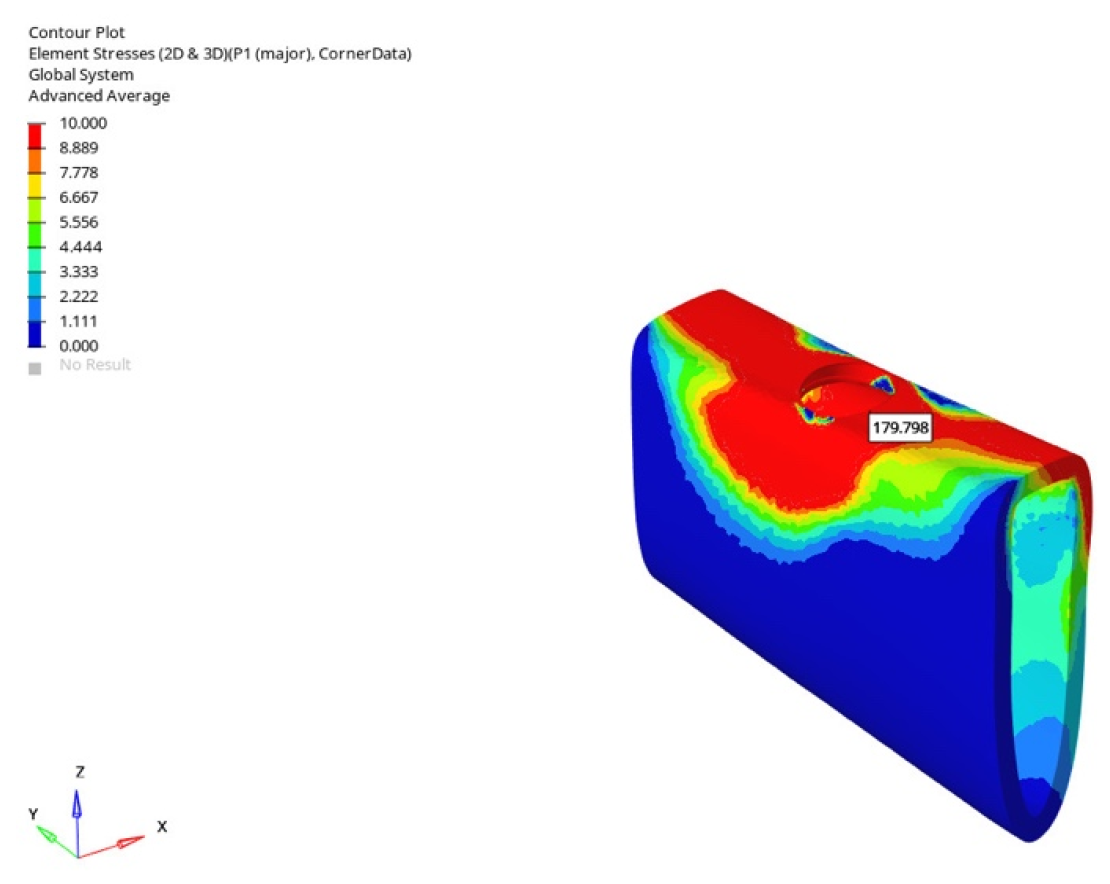
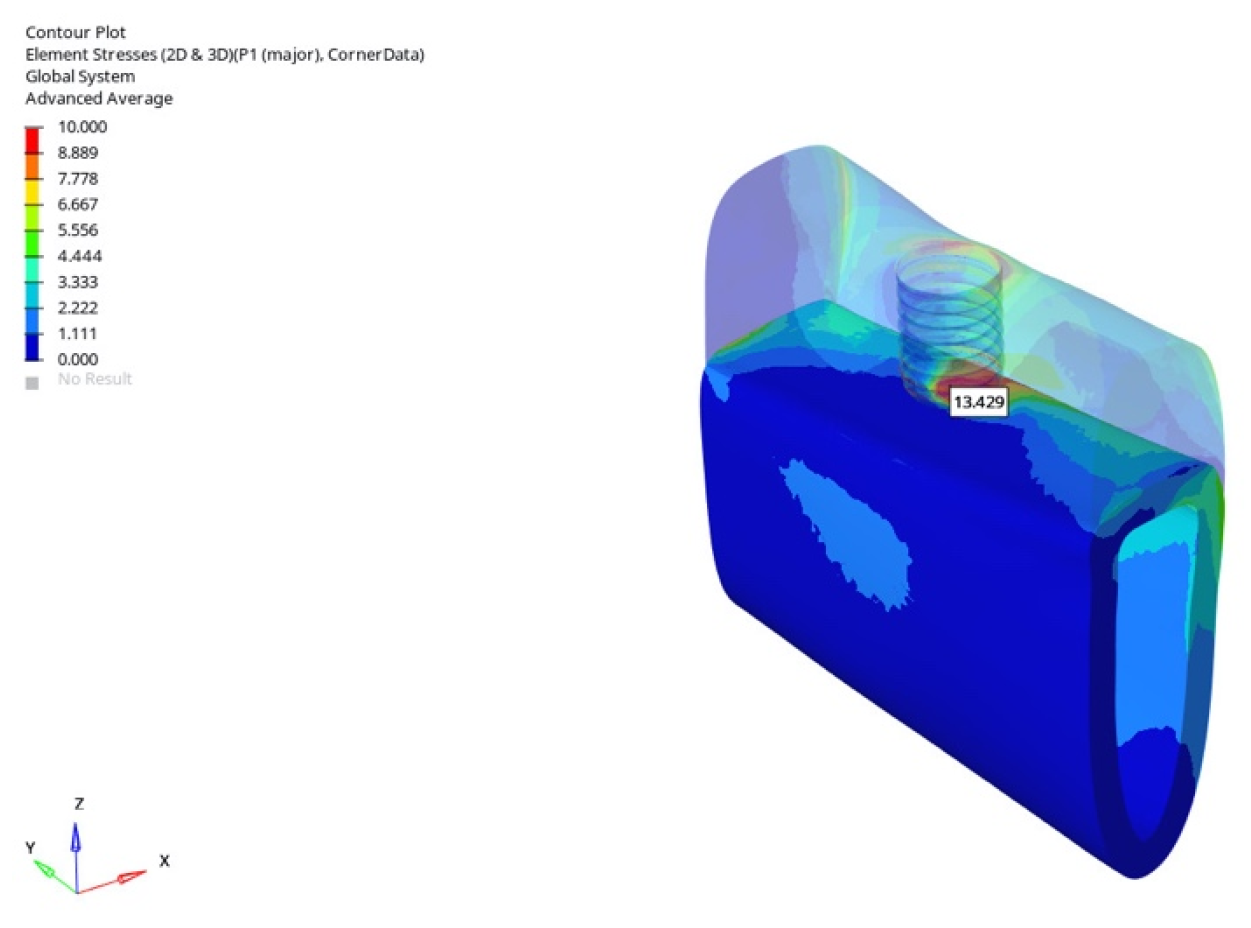



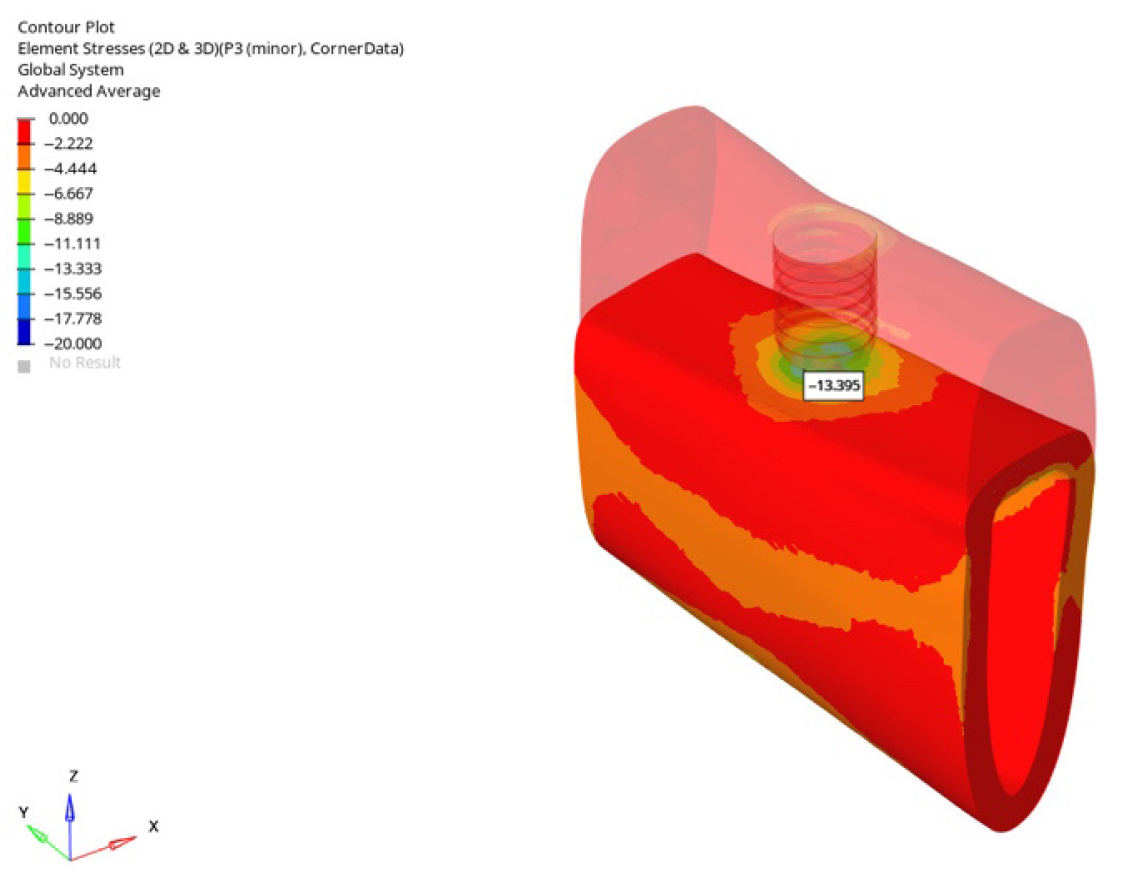
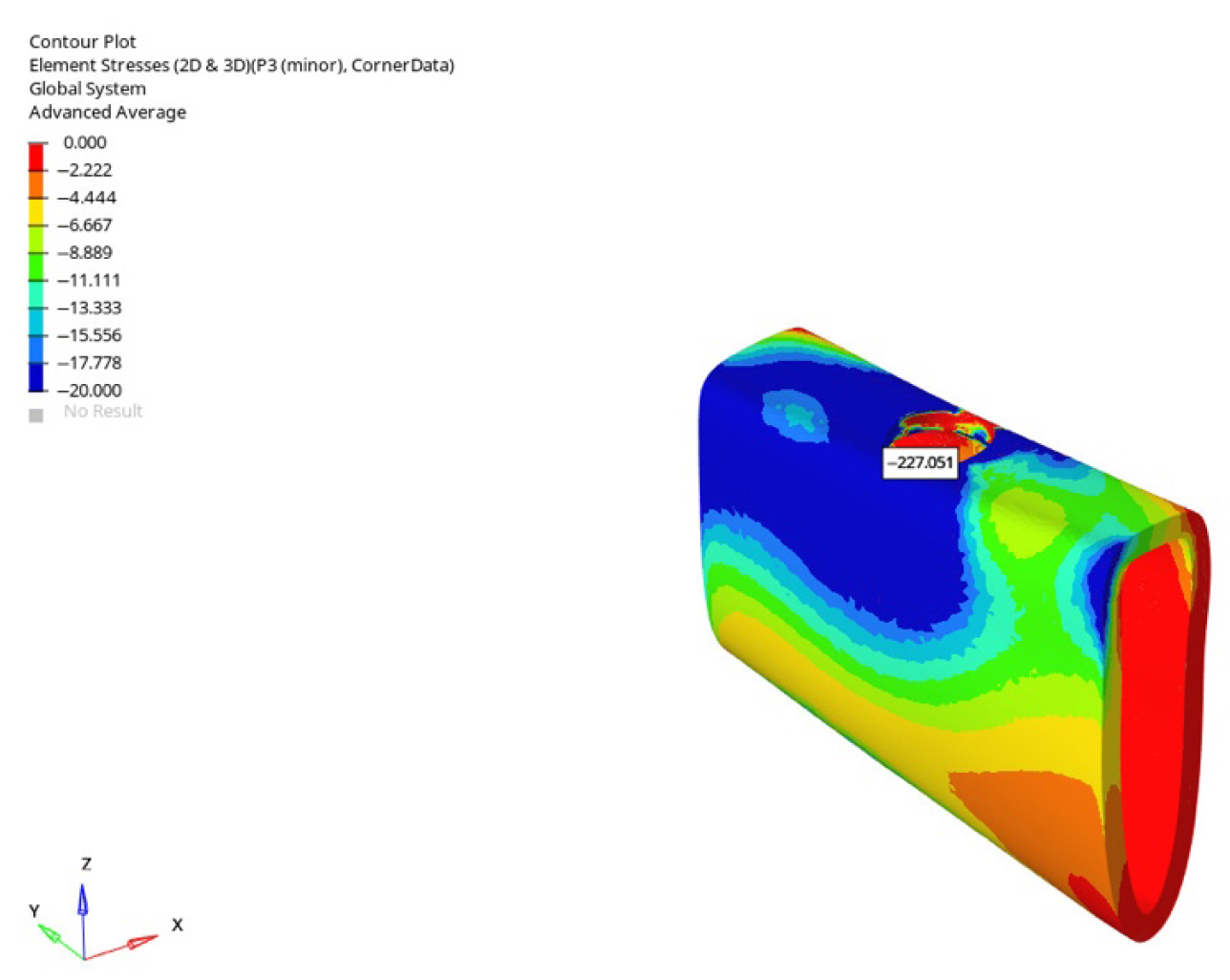


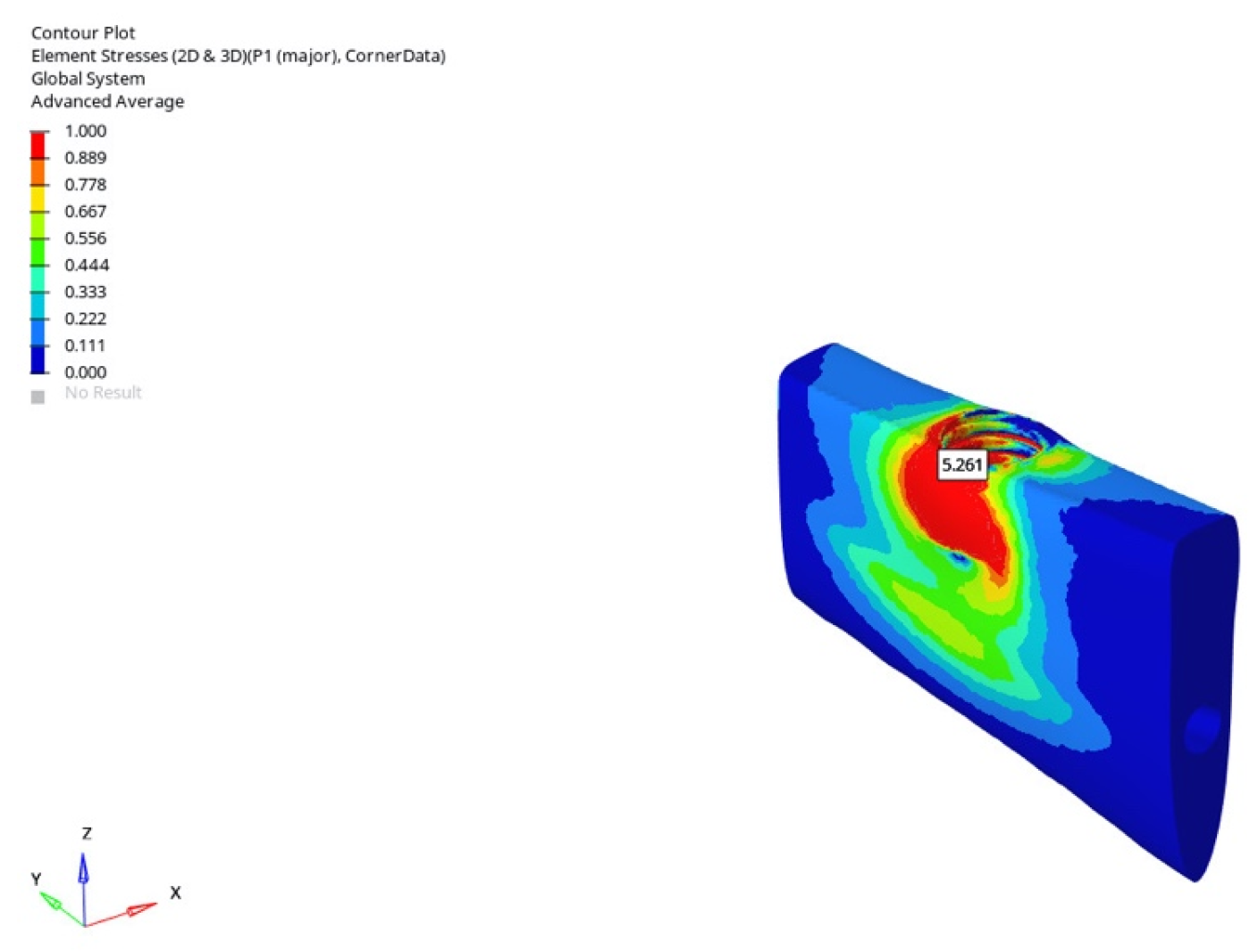
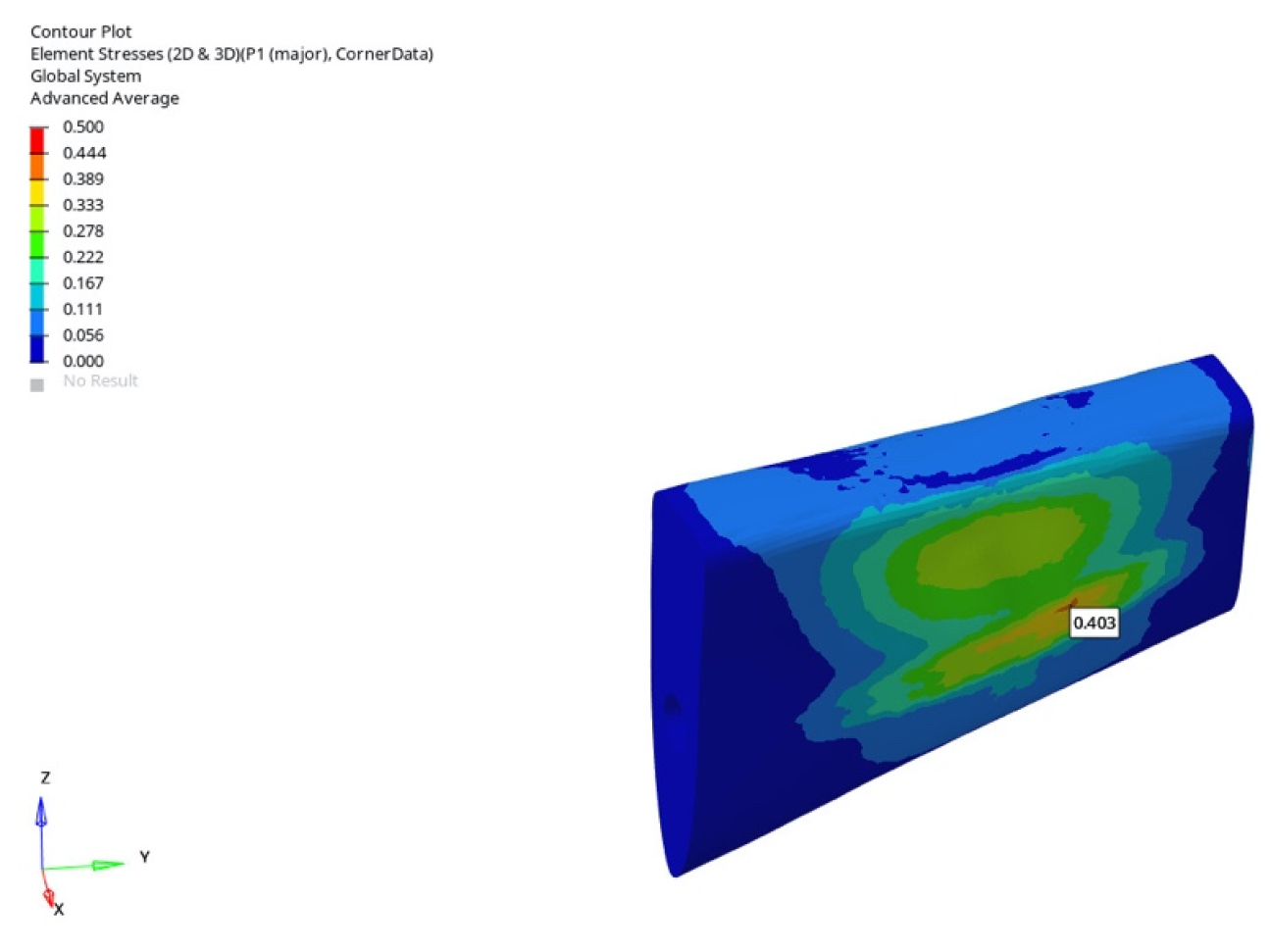


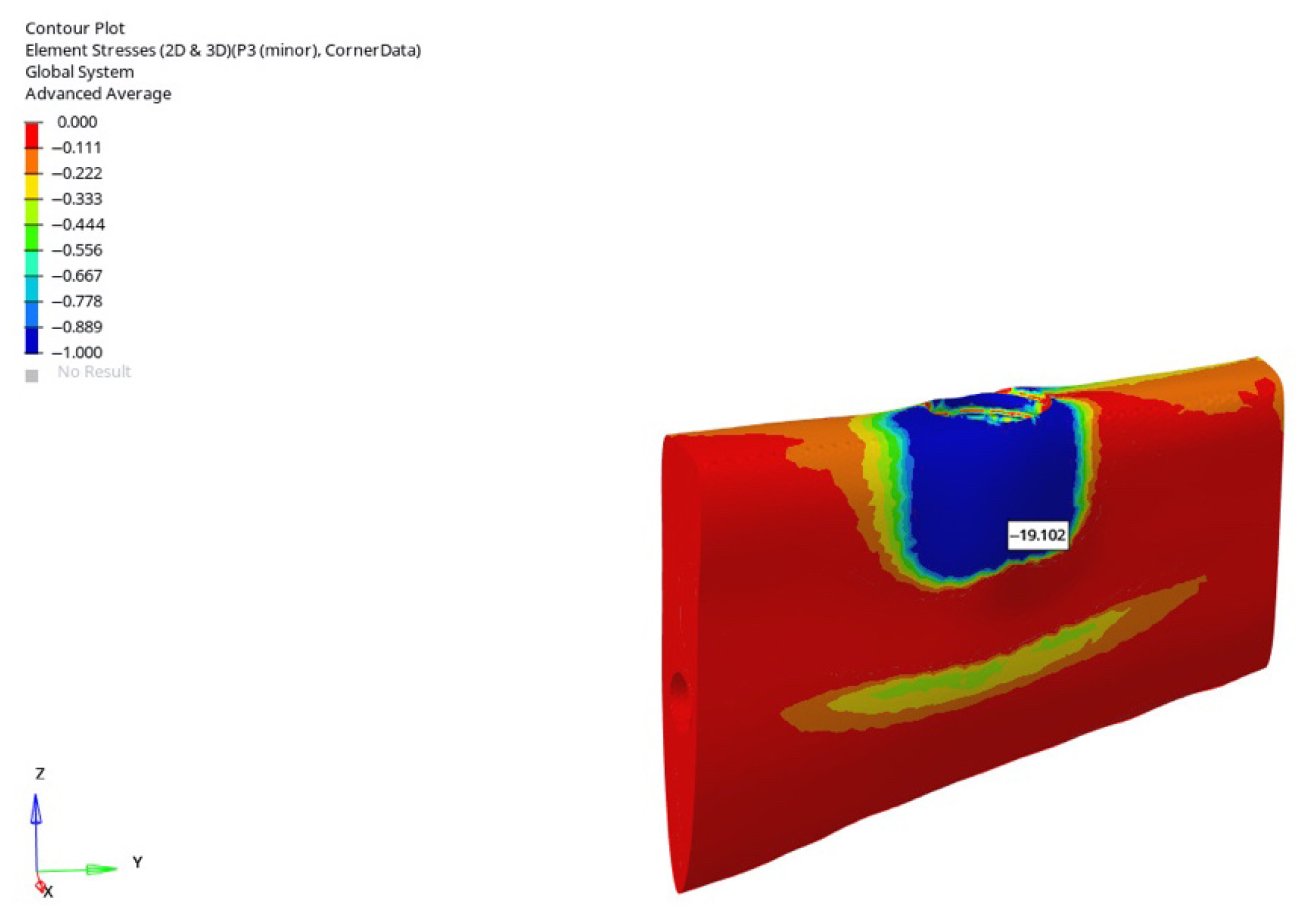
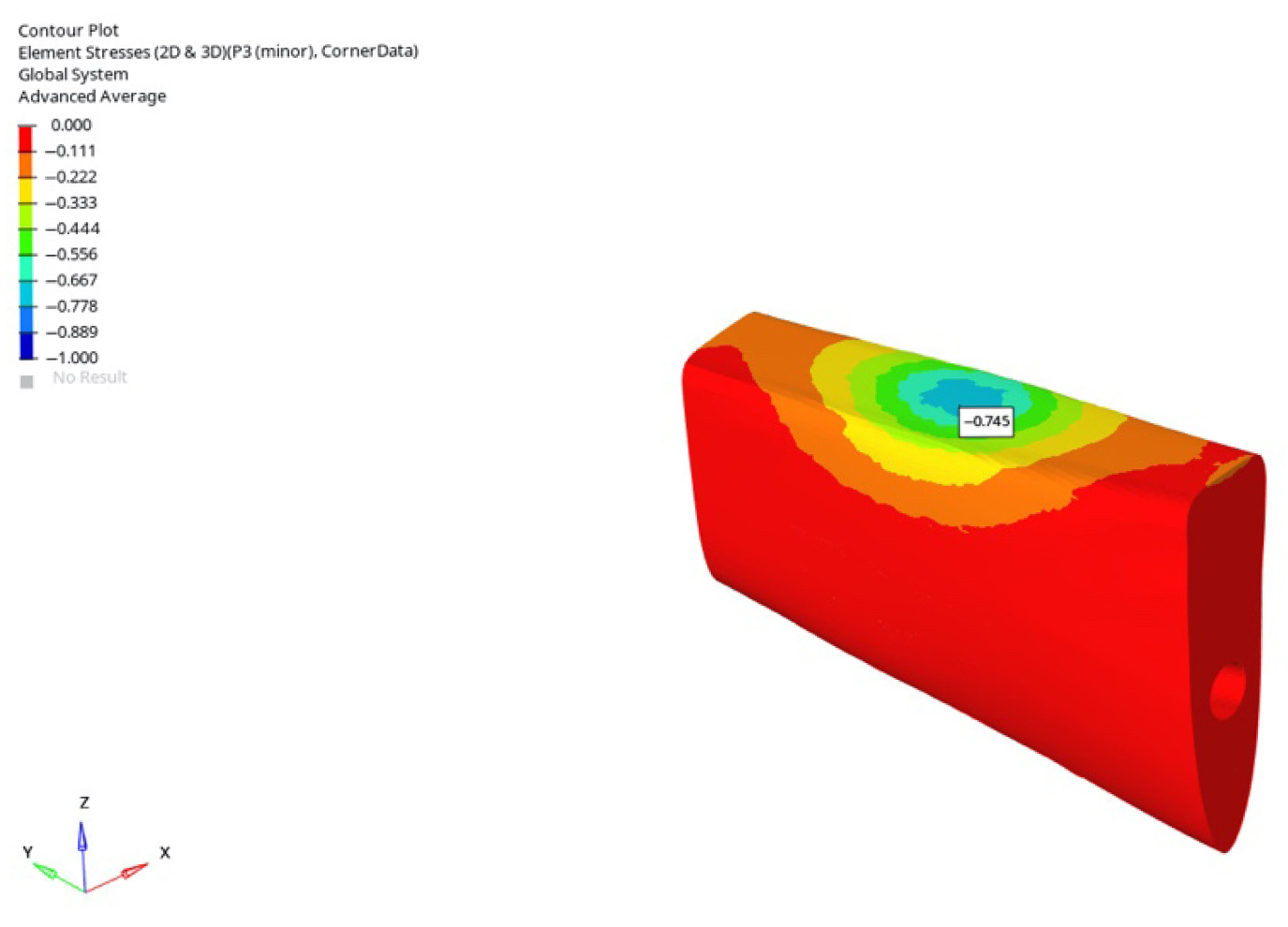
| Structural Feature | Normal (D2) | Grafted (D3) | Atrophic (D4) |
|---|---|---|---|
| Superior cortical bone (mm) | 2.0 | 1.5 | 1.0 |
| Superior trabecular bone (mm) | 13.0 | 12.5 | 7.0 |
| Inferior cortical bone (mm) | 2.0 | 1.5 | 1.0 |
| Inferior trabecular bone (mm) | 3.0 | 3.5 | 4.0 |
| Crest–canal top distance (mm) | 15.0 | 14.0 | 8.0 |
| Canal bottom–base distance (mm) | 5.0 | 5.0 | 5.0 |
| Total bone width (mm) | 10.0 | 8.0 | 6.0 |
| Model | Node Count | Element Count |
|---|---|---|
| Model 01 | 227,757 | 922,400 |
| Model 02 | 266,980 | 1,077,669 |
| Model 03 | 215,050 | 866,050 |
| Model 04 | 259,782 | 1,039,637 |
| Model 05 | 191,848 | 762,723 |
| Loading Scenario | Implant Length | VM Implant (MPa) | VM Abutment (MPa) | VM Mandibular Canal (MPa) | Cortical P1 (MPa) | Cortical P3 (MPa) | Trabecular P1 (MPa) | Trabecular P3 (MPa) |
|---|---|---|---|---|---|---|---|---|
| Immediate | 6 mm | 104.161 | 124.073 | 0.937 | 28.335 | −28.180 | 0.930 | −1.744 |
| 12 mm | 118.273 | 127.291 | 1.827 | 17.949 | −21.025 | 0.551 | −1.254 | |
| Early | 6 mm | 104.260 | 124.096 | 0.933 | 28.094 | −27.206 | 0.882 | −1.625 |
| 12 mm | 118.435 | 127.544 | 1.800 | 16.581 | −20.645 | 0.565 | −1.251 | |
| Delayed | 6 mm | 105.237 | 124.594 | 0.865 | 22.956 | −25.275 | 0.870 | −0.675 |
| 12 mm | 118.801 | 128.319 | 1.765 | 15.519 | −20.550 | 0.475 | −0.525 |
| Loading Scenario | Implant Length | VM Implant (MPa) | VM Abutment (MPa) | VM Mandibular Canal (MPa) | Cortical P1 (MPa) | Cortical P3 (MPa) | Trabecular P1 (MPa) | Trabecular P3 (MPa) |
|---|---|---|---|---|---|---|---|---|
| Immediate | 6 mm | 365.352 | 441.488 | 0.768 | 72.730 | −87.935 | 4.792 | −12.429 |
| 12 mm | 465.698 | 458.783 | 1.133 | 44.052 | −52.519 | 1.852 | −10.430 | |
| Early | 6 mm | 364.862 | 442.256 | 0.732 | 70.227 | −85.808 | 4.135 | −11.162 |
| 12 mm | 465.541 | 459.062 | 1.129 | 44.039 | −52.447 | 1.653 | −9.747 | |
| Delayed | 6 mm | 346.366 | 442.839 | 0.603 | 51.201 | −56.861 | 4.123 | −3.777 |
| 12 mm | 452.020 | 459.678 | 1.065 | 43.731 | −44.907 | 1.549 | −2.705 |
| Loading Scenario | Implant Length | VM Implant (MPa) | VM Abutment (MPa) | VM Mandibular Canal (MPa) | Cortical P1 (MPa) | Cortical P3 (MPa) | Trabecular P1 (MPa) | Trabecular P3 (MPa) |
|---|---|---|---|---|---|---|---|---|
| Immediate | 6 mm | 110.299 | 132.491 | 3.656 | 84.186 | −101.279 | 1.581 | −2.328 |
| Early | 6 mm | 110.817 | 132.856 | 3.503 | 79.110 | −90.546 | 1.467 | −1.824 |
| Delayed | 6 mm | 111.314 | 134.434 | 3.146 | 60.650 | −71.909 | 1.411 | −1.635 |
| Loading Scenario | Implant Length | VM Implant (MPa) | VM Abutment (MPa) | VM Mandibular Canal (MPa) | Cortical P1 (MPa) | Cortical P3 (MPa) | Trabecular P1 (MPa) | Trabecular P3 (MPa) |
|---|---|---|---|---|---|---|---|---|
| Immediate | 6 mm | 403.720 | 463.917 | 5.227 | 179.798 | −227.051 | 5.261 | −19.102 |
| Early | 6 mm | 402.139 | 465.360 | 4.994 | 157.496 | −225.500 | 5.257 | −17.006 |
| Delayed | 6 mm | 387.755 | 466.400 | 3.797 | 118.069 | −131.396 | 5.069 | −6.797 |
| Loading Scenario | Implant Length | VM Implant (MPa) | VM Abutment (MPa) | VM Mandibular Canal (MPa) | Cortical P1 (MPa) | Cortical P3 (MPa) | Trabecular P1 (MPa) | Trabecular P3 (MPa) |
|---|---|---|---|---|---|---|---|---|
| Immediate | 6 mm | 104.278 | 127.166 | 1.891 | 16.391 | −14.471 | 0.409 | −0.786 |
| 12 mm | 118.435 | 127.359 | 2.480 | 16.828 | −25.131 | 0.634 | −1.508 | |
| Early | 6 mm | 104.656 | 127.168 | 1.891 | 16.174 | −14.043 | 0.405 | −0.780 |
| 12 mm | 127.093 | 127.629 | 2.426 | 16.675 | −24.323 | 0.567 | −1.500 | |
| Delayed | 6 mm | 105.625 | 127.189 | 1.888 | 15.221 | −13.395 | 0.403 | −0.745 |
| 12 mm | 128.247 | 128.640 | 2.287 | 15.485 | −23.007 | 0.514 | −1.484 |
| Loading Scenario | Implant Length | VM Implant (MPa) | VM Abutment (MPa) | VM Mandibular Canal (MPa) | Cortical P1 (MPa) | Cortical P3 (MPa) | Trabecular P1 (MPa) | Trabecular P3 (MPa) |
|---|---|---|---|---|---|---|---|---|
| Immediate | 6 mm | 392.595 | 447.861 | 2.171 | 15.832 | −38.615 | 0.591 | −0.869 |
| 12 mm | 471.828 | 458.023 | 2.971 | 32.591 | −17.908 | 1.115 | −6.715 | |
| Early | 6 mm | 391.753 | 448.331 | 2.140 | 14.728 | −36.749 | 0.572 | −0.851 |
| 12 mm | 471.496 | 458.262 | 2.934 | 25.856 | −17.629 | 1.081 | −5.548 | |
| Delayed | 6 mm | 389.284 | 449.454 | 2.051 | 13.429 | −21.010 | 0.539 | −0.810 |
| 12 mm | 470.746 | 459.382 | 2.263 | 21.432 | −15.442 | 0.977 | −5.138 |
Disclaimer/Publisher’s Note: The statements, opinions and data contained in all publications are solely those of the individual author(s) and contributor(s) and not of MDPI and/or the editor(s). MDPI and/or the editor(s) disclaim responsibility for any injury to people or property resulting from any ideas, methods, instructions or products referred to in the content. |
© 2025 by the authors. Licensee MDPI, Basel, Switzerland. This article is an open access article distributed under the terms and conditions of the Creative Commons Attribution (CC BY) license (https://creativecommons.org/licenses/by/4.0/).
Share and Cite
Has, L.C.; Orbak, R. Effect of Bone Quality, Implant Length, and Loading Timing on Stress Transmission in the Posterior Mandible: A Finite Element Analysis. Bioengineering 2025, 12, 888. https://doi.org/10.3390/bioengineering12080888
Has LC, Orbak R. Effect of Bone Quality, Implant Length, and Loading Timing on Stress Transmission in the Posterior Mandible: A Finite Element Analysis. Bioengineering. 2025; 12(8):888. https://doi.org/10.3390/bioengineering12080888
Chicago/Turabian StyleHas, Ladise Ceylin, and Recep Orbak. 2025. "Effect of Bone Quality, Implant Length, and Loading Timing on Stress Transmission in the Posterior Mandible: A Finite Element Analysis" Bioengineering 12, no. 8: 888. https://doi.org/10.3390/bioengineering12080888
APA StyleHas, L. C., & Orbak, R. (2025). Effect of Bone Quality, Implant Length, and Loading Timing on Stress Transmission in the Posterior Mandible: A Finite Element Analysis. Bioengineering, 12(8), 888. https://doi.org/10.3390/bioengineering12080888







